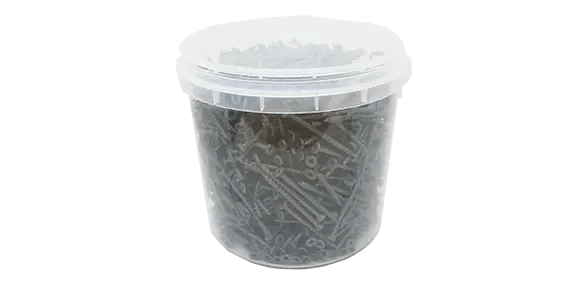Decking Screws
(21 Products)Decking screws are purpose-built to handle the demands of exterior construction - holding everything in place through years of use, changing weather, and seasonal movement. Whether you're starting a new build or replacing a few worn planks, the right screws make a noticeable difference in durability and finish.
What are Decking Screws?
Decking screws are built with the outdoors in mind. They’re tougher, more weather-resistant, and better suited to the kinds of materials used in decks.
Compared to standard screws, which might rust out, split the wood or mushroom, decking screws hold firm and stay put, year after year.
Here’s what you’ll usually see in a quality decking screw:
- Protective coatings that stand up to moisture - stainless steel or specially coated steel is common to stop rust and stains from forming
- Sharp tips that cut into the wood without needing to pre-drill in most cases (especially helpful with softwoods)
- Deep, aggressive threads that grip the wood tightly.
- Low-profile heads, often countersunk or trim-style. The screw sits flush with the deck surface and doesn’t snag feet or furniture
How to Choose the Right Decking Screws
The material you're using, where the deck is located, and even the look you’re going for can affect your choice of screw.
Decking Material
- Pressure-treated wood: Look for coated steel or ceramic-finished screws that can resist corrosion caused by treated lumber chemicals.
- Hardwoods (like Ipe or Teak): Stainless steel screws (typically 305 or 316 grade) are the safest choice to avoid staining or snapping under pressure.
- Composite decking: Use screws designed for composites. These usually have special heads and threads to prevent surface bubbling or mushrooming.
Length and Threading
As a general rule, screws should be at least 2.5 times the thickness of your deck boards.
Partially threaded screws pull the board tight to the joist, while fully threaded options help with stability in shifting climates or high-traffic areas.
Screw Head Style
- Flat or countersunk heads help keep the surface smooth and snag-free.
- Trim heads offer a smaller footprint - great for hardwoods or where appearance matters.
- Bugle heads spread pressure more evenly, which can help avoid splitting.
Why the Right Screws Matter
The screws you use on a deck can make or break the whole thing - literally. Pick the wrong kind, and you could end up dealing with rust stains running down your boards, warped planks that won’t stay put, or even screws that snap when the wood shifts or swells.
On the other hand, going with proper decking screws gives you peace of mind. They hold tighter, last longer, and keep your deck looking sharp without the constant need for repairs. It’s a small detail that makes a big difference in the long run.
A Few Tips for Installing Decking Screws
If you’re working with hardwood decking, it’s a good idea to pre-drill, especially close to the ends of the boards. It helps keep the wood from splitting, which can be a real issue with denser species.
Use a drill with adjustable torque (a clutch setting). It’ll save you from stripping the screw heads or sinking them too deep. Overdriving is easy to do if you’re not paying attention, especially with softer materials.
Take your time lining up your screws. Even spacing and straight rows might not seem important at first, but they make a big difference in how the finished deck looks.
Lastly, double-check that the screws you're using are actually meant for outdoor use. It sounds obvious, but indoor screws will corrode faster than you'd expect once they're exposed to rain, sun, or salty air.
Frequently Asked Decking Screws Questions
Do I Need to Pre-Drill Before Using Deck Screws?
Pre-drilling is recommended for hardwoods to prevent splitting and to ensure easier insertion of the screws. For softer woods, many decking screws are designed with features that may eliminate the need for pre-drilling.
How Do I Choose The Right Length for Decking Screws?
The length of the screw should be at least 2.5 times the thickness of your decking board to ensure a secure fit without penetrating the underlying structure.
Can I Use Regular Screws or Nails Instead of Decking Screws For My Deck?
While regular screws might be used temporarily, they lack the corrosion resistance and specific design features of decking screws, which are essential for the longevity and safety of decking projects.
How Many Screws Do I Need For My Decking Project?
The number of screws required depends on the size of your deck and the spacing of the boards. It's recommended to use two screws per joist for each decking board to ensure stability.






